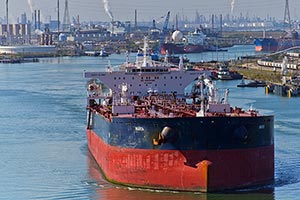Larger Ships Prove Challenging for Port of Corpus Christi

It's one thing to say ship traffic at the Port of Corpus Christi is climbing while using reports and PowerPoint presentations.
Illustrating the challenges the nation's fifth-largest port faces as energy companies shift to larger vessels could only be done from the water.
Officials from Port Industries of Corpus Christi did just that on April 11.
The trade association represents more than a dozen energy companies that operate within the port. It organized a four-hour boat tour of the port's Inner Harbor and LaQuinta Channel to give vendors and representatives from the city of Corpus Christi an intimate view of how more than 8,000 vessels, from flat barges to massive tankers, maneuver through the port's waters each year.
RELATED: Texas’ Port of Corpus Christi gets ally in North Dakota senator
The task has gotten more difficult recently as available waterfront property has become scarce, and narrower segments have gotten trickier to navigate for larger vessels carrying heavier loads.
Sean Strawbridge, the deputy executive director and chief operating officer for the port, said a delegation from the port recently returned from Washington, where they pitched the merits of the port's long-discussed effort to deepen and widen the Corpus Christi Ship Channel. Although there has not yet been confirmation of federal help, port officials remain confident their chances are better for assistance with the $350 million project.
Port commissioner Richard Valls Jr. said the improvements are crucial to ensure safety as traffic on port waterways increases. That has become especially important as more companies pivot toward using natural gas, which experts say is in abundance in the Texas Coastal Bend.
RELATED: Port of Corpus Christi sizes up infrastructure to better handle growth
"Things out here are changing pretty fast. That means more traffic," Valls said. "We've got to be able to keep pace."
Port officials have twice gotten approval from Congress to widen the ship channel from Port Aransas to the Harbor Bridge, and to deepen it from 45 feet to 52 feet.
The channel project most recently was left off the Corps of Engineers' funding list in 2016. The Port Authority this year approved $2.1 million in contracts to hire consultants to conduct sediment testing and other studies until additional funding can be found.
Supramax and handymax vessels can carry up to 60,000 tons and 35,000 tons of cargo, respectively; they're the most commonly seen in the port, though larger "Mini" capsize ships, which are capable of hauling up to 100,000 tons, also are making calls to Corpus Christi.
Larger Panamax-class ships, a variety of mid-sized cargo vessels that measure about 960 feet in length and nearly 200 feet wide, are expected to become more commonplace with the completion last year of the Panama Canal expansion.
Bob Paulison, Port Industries' executive director, said improvements will be necessary soon as companies continue to court bigger ships for their products.
"These kinds of infrastructure projects take a long time to plan and execute," Paulison said. "But it's important that we find ways to make sure we're keeping products moving in and out of the area efficiently and safely."
More than 8,100 vessels sailed through the port in 2016, carrying a total of 94.3 million tons of cargo, according to port financial records. The majority of the cargo — 85% of it — was petroleum product. In the first two months of 2017, 17 million tons of cargo sailed through the port on nearly 1,100 vessels, port financial records show.
Distributed by Tribune Content Agency, LLC

